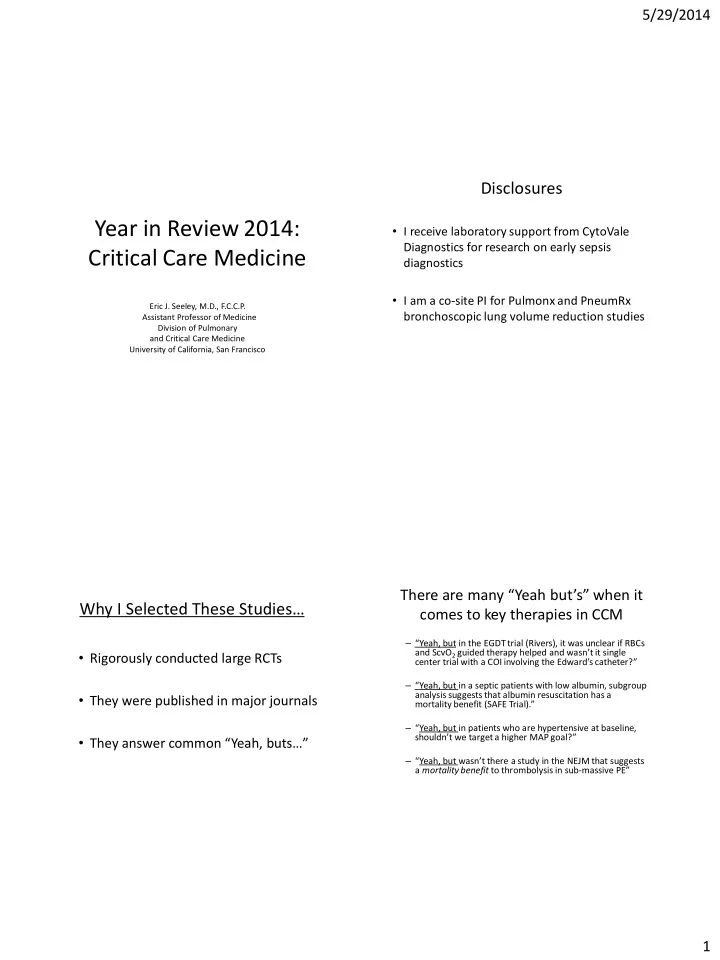

5/29/2014 Disclosures Year in Review 2014: • I receive laboratory support from CytoVale Diagnostics for research on early sepsis Critical Care Medicine diagnostics • I am a co-site PI for Pulmonx and PneumRx Eric J. Seeley, M.D., F.C.C.P . bronchoscopic lung volume reduction studies Assistant Professor of Medicine Division of Pulmonary and Critical Care Medicine University of California, San Francisco There are many “Yeah but’s” when it Why I Selected These Studies… comes to key therapies in CCM – “Yeah, but in the EGDT trial (Rivers), it was unclear if RBCs and ScvO 2 guided therapy helped and wasn ’ t it single • Rigorously conducted large RCTs center trial with a COI involving the Edward ’ s catheter? ” – “Yeah, but in a septic patients with low albumin, subgroup analysis suggests that albumin resuscitation has a • They were published in major journals mortality benefit (SAFE Trial).” – “ Yeah, but in patients who are hypertensive at baseline, shouldn ’ t we target a higher MAP goal? ” • They answer common “Yeah, buts…” – “ Yeah, but wasn ’ t there a study in the NEJM that suggests a mortality benefit to thrombolysis in sub-massive PE ” 1
5/29/2014 “Yeah, but in the EGDT trial (Rivers), it was unclear if RBCs and ScvO 2 guided therapy helped and wasn ’ t it single center trial with a COI involving the Edward ’ s catheter? ” NEJM 2014 • Multicenter, RCT in US • Rivers EGDT NEJM 2001 – 31 ERs, 1341 Patients with Septic Shock – Single center study of 263 pts • 2 SIRS + SBP < 90 despite fluid or lactate > 4 – Mortality in EGDT 30.5% vs 46.5% – Randomized to 1 of 3 protocols in first 6 hours – Widely “adopted” in clinical practice – Kind of… 1.Early Goal Directed Therapy (EGDT) – Adopted into the surviving sepsis guidelines - River’s protoco l (ScVO2, Blood, Dobutamine) 2.Protocol-Based Standard Therapy - River’s light (CVC as needed, less blood, no ScVO2 goal) • All of these unanswered ?s led to ProCESS 3.Usual Care - What ERs in academic centers usually do What Actually Happened? EGDT Protocol Protocol Based – STD Vs. Rivers “light” Edwards Catheter No CVP Hct >30 Hct >21 Dobut if ScvO 2 <70% No ScvO 2 goal Scv0 2 Monitoring Central Line Insertion Shock Index = HR/SBP IVF Volume 2
5/29/2014 No Difference in 60 day or 1 year cumulative mortality Take away… - No need for: • Edwards Catheter (put next to the PA-Catheter) • Transfusion goal of Hct >30% (Hct 21 better) • Dobutamine guided by ScvO 2 • Central line NOT ESSENTIAL for hemodynamic monitoring (i.e. CVP probably as bad as we think) NEJM 2014 ALBIOS Study Investigators (Caironi, Gattinoni) ALBIOS Study Investigators (Caironi, Gattinoni) March 18, NEJM 2014 March 18, NEJM 2014 • “Yeah, but in septic patients with low albumin, subgroup analysis suggests that albumin has a mortality benefit” • SAFE trial (2004): NS vs. 4% Albumin in Critically Ill • Severe sepsis subgroup – lower risk of death but p > 0.05 – ALBIOS Study Design • 100 ICUs in Italy, 1818 pts with severe sepsis/septic shock • 20% albumin and crystalloid vs. crystalloid alone • Target was Albumin > 30 g/L (3.0 g/dL) • Primary outcome was death at 28 days 3
5/29/2014 ALBIOS Study Investigators (Caironi, Gattinoni) March 18, NEJM 2014 ALBIOS Study Investigators (Caironi, Gattinoni) March 18, NEJM 2014 Take Away… • Hard to justify added expense of Albumin for sepsis resuscitation SEPSISPAM Investigators* NEJM March 2014 SEPSISPAM Investigators* NEJM March 2014 “ Yeah, but in patients who are hypertensive at baseline, shouldn ’ t we target a higher MAP goal? ” >85 Surviving sepsis guidelines recommend • MAP > 65 in patients with septic shock • Based on human/animal studies of lactate and RBF >65 Trial Design • Multi-center RCT in French ICUs • 776 patients with septic shock • Randomized to MAP > 65 vs. MAP > 85 4
5/29/2014 SEPSISPAM Investigators* NEJM March 2014 SEPSISPAM Investigators* NEJM March 2014 You could consider higher MAP goals in patients with chronic HTN who are at low risk for afib. P=0.57 P=0.57 JAMA April 2014 JAMA April 2014 101,064 patients in Australia/NZ 101,064 patients in Australia/NZ with severe sepsis/septic shock with severe sepsis/septic shock But it’s not all bad news… But it’s not all bad news… 5
5/29/2014 How do we treat submassive PE? How do we treat submassive PE? PE Heparin +/- Heparin +/- Thrombolytics? Heparin Thrombolytics? How do we treat submassive PE? How do we treat submassive PE? Massive PE: Massive PE: Heparin + Thrombolytics Heparin + Thrombolytics PE PE Sub-massive/ Heparin +/- Heparin +/- Intermediate PE Heparin Thrombolytics? Heparin Thrombolytics? Therapy Unclear 6
5/29/2014 “ Yeah, but there was a study in the NEJM that suggest a mortality benefit to thrombolysis in sub-massive PE ” Konstantinides NEJM 2002 NEJM 2014 PEITHO investigators MAPPET-3 Trial • Multi-center RCT in Europe • 1005 patients with Intermediate Risk-PE – HD Stable with RV dysfunction and + trop • Randomized to: – Tenectaplase + Heparin vs. Heparin alone • Primary Outcome ***Composite Primary End-point driven only by secondary thrombolytics****** – Death or hemodynamic collapse 7 days after txt Event = Composite End Point Conclusions: Ending the “Yeah, buts…” • For Septic Patients – You can do away with ScvO 2 and CVP guided therapy – There is no benefit to a higher Hb goal in EGDT – No benefit to Albumin in sepsis resuscitation – No benefit to MAP > 85 except in chronic HTN • For Intermediate/Submassive PE – Probably better to start with Heparin and thrombolyse for hemodynamic decompensation • (ie. Only for massive PE) Stroke Patients, 8/10 were >70 yo. Youngest was 65, 4/10 survived 7
5/29/2014 Questions? 8
Recommend
More recommend